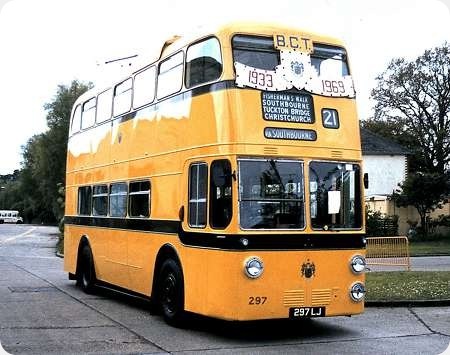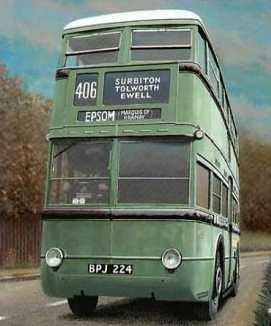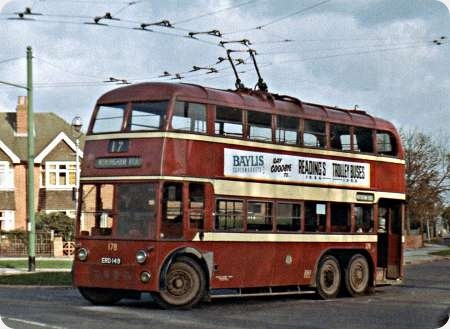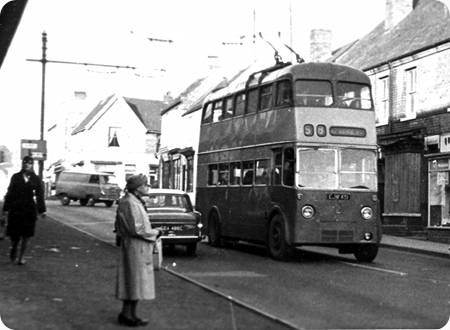
Copyright Tony Martin
Wolverhampton Corporation
1948
Sunbeam W
Roe H32/28R (1960)
Passing through Sedgley on its way back to its home town, Wolverhampton 451 was nearing the end of its days in early 1967. Built in 1948 with a Park Royal body and rebodied in 1960, these vehicles saw out the once extensive Wolverhampton trolleybus system. It is working on route 58 from Dudley to Wolverhampton, which in its time had seen horse steam and electric trams and also, incidentally, the only trolleybus route to enter Worcestershire. The end came on March 5th 1967.
Photograph and Copy contributed by Tony Martin
14/03/13 – 09:02
Thanks, Tony for posting this reminder of how many Roe trolleybus rebuilds there were. It has always puzzled me why Roe got so much of this trolleybus rebuild business. Did they actively seek it, or was it simply available capacity? In any event, they were a smart addition to the street scene, but many sadly never had a full life, being prematurely scrapped on system conversion. Apart from Wolverhampton, and purely from memory, Roe rebuilt trolleybuses of this style operated in Doncaster, Teesside, Maidstone and Ashton. Anywhere else?
Paul Haywood
14/03/13 – 09:50
You partly answer your own question, Paul. Doncaster, Teesside, Wolverhampton and Ashton were established Roe customers. [Don’t know about Maidstone.] Roe were experienced at bodying trolleybuses. QED. Go where you had experience of the expertise.
David Oldfield
14/03/13 – 10:01
They also rebodied 6 wheelers for Huddersfield and Rotherham.
Eric Bawden
14/03/13 – 15:47
Actually Paul, it wasn’t just trolleybuses. Roe also re-bodied hundreds of War-time utility Guys.
David Oldfield
14/03/13 – 15:48
I think the fact that Roe bodies were teak framed as opposed to metal framed had something to do with it. Trolleybuses had to pass some sort of earth leakage resistance test and with wood being an insulator rather than a conductor of electricity wooden framing aided the bodywork in complying with the earth leakage requirements. Can anybody confirm?
Philip Halstead
14/03/13 – 15:49
David, the situation regarding Ashton and Roe is not as you describe. Ashton only bought two Roe bodies on new chassis prior to the first PD2s delivered in 1960, these being 65 and 66 on Sunbeam W chassis which were delivered in 1946 when their traditional suppliers, Crossley and English Electric, were unavailable for different reasons.
When it was decided to rebody wartime trolleybuses in 1954/5 the work went to Bond who rebodied 2 Sunbeams, being 63 and 64. In 1956 eight new BUT trolleybuses were ordered and bodied by Bond and it had been intended that wartime Sunbeams 61 and 62 would be rebodied by the Wythenshawe concern but the company closed so the contract was put out again to tender which was won by Roe in 1957.
The last motor bus deliveries to Ashton prior to this was for the Bond bodied Guy Arabs which were originally numbered 37-40 and delivered in 1956.
The 1957 Roe bodies for the Sunbeams must have impressed because the next vehicles ordered were thee 1960 PD2s and Ashton stayed with Roe until 1967 when East Lancs bodied Leopards were ordered followed by Northern Counties bodied Atlanteans in 1969.
Phil Blinkhorn
14/03/13 – 15:50
So if both Wolverhampton and Dudley were then in Staffordshire, where did the t/buses stray into Worcestershire, Tony?
Although I think much of Ted Heath’s county re-organisation was wrong, there were some mismatches. It was bizarre that enormous Birmingham was in Warwickshire, with its small, peaceful, market town.
Chris Hebbron
14/03/13 – 16:14
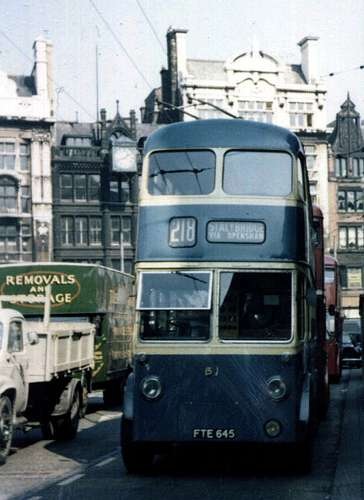
Would love to know the answer to whether Roe actively canvassed the trolleybus rebodying business or just that were a very good bodybuilder. The Roe bodies always looked elegant and so up-to-date on trolleybuses and very modern for the time.
Attached is one of my first colour photos of Ashton 61 in Piccadilly, Manchester in the last week of trolleybuses.
Ian Lynas
14/03/13 – 17:31
Well Ian. Regardless of whether they did any canvassing they were a very good body-builder – one of the best.
David Oldfield
15/03/13 – 08:29
Chris H, Dudley was a County Borough in a detached portion of Worcestershire. Before the political meddlers leapt in, parts of the Lake District were in a detached portion of Lancashire – 3/4 of the Windermere shoreline was, but the water itself was entirely in Westmorland.
Pete Davies
15/03/13 – 08:30
Philip’s point on earthing. When I first started bus work in 1967, I was told by one of Newcastle Corporation’s drivers that you could always tell a former Trolleybus conductor by the way they boarded a bus, apparently they would never grab hold of the centre platform rail
Ronnie Hoye
15/03/13 – 08:37
The newish Roe rebodies on Doncaster’s second hand trolleys found themselves new motor-bus chassis and half cabs when the trolleys were withdrawn and some of these chassis in turn were quite old- but some were brand new. You could tell which they were- as remarked here before- because they had the old cable trunking in the upstairs window frames and some of the bodies were a bit proud & vertical at the front. I also think that the Corporation did a lot of the conversion work themselves?
Joe
15/03/13 – 17:55
Bradford Corporation Passenger Transport obtained sanction in November 1950 for 12 new bodies for their 1938/39 AEC 661Ts and Karrier E4s, but an offer from C H Roe to supply 7′ 6" wide bodies at a lower cost than those previously supplied for 8′ 0" wide BUTs 740 – 751 was rejected by the City Council, who insisted on completive tender. The successful company was Crossley Motors who supplied them in 1952 and a photo of one of these trolleybuses has previously been posted on this web site by me and can be seen here.
Clearly this is evidence that C H Roe was actively seeking business, but had their offer been accepted, Bradford may well have followed a different trolleybus re-bodying route from 1956 onwards.
Richard Fieldhouse
16/03/13 – 07:45
Thx, Pete D. I recall when struggling with Hardknott Pass in the Lake District some years ago, coming across a tall stone post with ‘Lancashire’ on it, many miles from where I would have expected to see it in ‘old money!’
Chris Hebbron
16/03/13 – 07:47
Thanks, Richard, for this interesting information regarding Bradford and Roe’s failed attempt to obtain the trolleybus rebuild business. It has always puzzled me why Bradford went to East Lancs in such a big way and this helps to explain it. Indeed, it would have been fascinating to have seen Roe’s version of the last trolleybus rebuilds in Bradford. Smart as the 1962 East Lancs rebuilds were, I venture to suggest that a trolleybus version of the Leeds 1962 *** CNW front-entrance bodies would have been something really special.
Paul Haywood
16/03/13 – 16:58
Puzzle no longer, Paul: Bradford was proud, trad Bradford and CH Roe were in LEEDS! The twain did not always meet and the good burghers might prefer to look west for their tracklesses as it wasn’t really safe to go further east than English Electric at Thornbury.
Joe
12/07/13 – 07:53
I am fortunate to have the opportunity to drive a similar vehicle to this one, namely DUK 833, fleet No 433 at the Black Country Museum, I have heard it mentioned that trolleybuses were built using wooden frames for electrical insulation purposes.
I was also once told that the teak Roe used was imported into the UK as ships ballast! Our trolleybuses are tested for earth leakage each time they go into service at the museum. When trolley buses in regular service during the winter time when there could be heavy slush finding it’s way into areas that would normally not get water intrusion it was not unusual for passengers to get a slight electric "tingle" from touching a stanchion ect and apparently the normal practice was to take the bus out of service so that it could dry out.
William Parker
06/02/14 – 08:33
Further to the Worcestershire comment, Dudley was part of Worcs detached until the local government reorganisation of the 1970s.
Tony Martin
06/02/14 – 16:33
A couple of years ago a car enthusiast friend of a friend asked why the West Yorkshire Road Car Co. had had its headquarters in Harrogate, which is in North Yorkshire. He said he hadn’t realised that the town had been in the West Riding of Yorkshire prior to local government reorganisation in 1974, but being an "off comed ‘un" maybe he could be excused. The nearby city of Ripon was also home to a bus depot, which was unusual in being United Automobile’s only one located in the West Riding of Yorkshire, as far as I’m aware.
Brendan Smith
22/04/17 – 10:30
The information about Trolley Bus 451, passing through Sedgley is not correct. The bus has just passed the junction of Bilston Street, towards Sedgley Bull Ring, on its way to Dudley.
I was a Wolverhampton Corporation Trolley Bus driver till 1960, and then at Wolverhampton and Dudley Midland Red, till the garage closed, as a Midland Red driver. Retired eventually back at Wolverhampton, when Dudley closed, taken over by WMPTE, then West Midland Travel.
John Dawson
